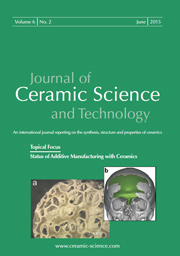Articles
All articles | Recent articles
Surface Strengthening of Extrusion-Formed Polymer/Filler-Derived Ceramic Composites
L. Schlier1, N. Travitzky1, J. Gegner2, P. Greil1
1 Department of Materials Science, (Glass and Ceramics), University of Erlangen-Nuernberg, Martensstr. 5, 91058 Erlangen, Germany
2 Department of Material Physics, SKF GmbH, Gunnar-Wester-Str. 12, 97421 Schweinfurt, Germany
received June 4, 2012, , accepted July 25, 2012
Vol. 3, No. 4, Pages 181-188 DOI: 10.4416/JCST2012-00018
Abstract
Surface nitridation of extrusion-formed Fe-Si-Cr-filler-loaded polysiloxane polymer filaments was investigated. After the filaments were exposed to a nitrogen atmosphere at temperatures above 1000 °C, a gas-solid reaction caused the formation of a nitridation reaction layer covering the filament surface. Thermo-chemical calculations of equilibrium phase compositions at different nitrogen activity suggest the formation of Si2N2O and Si3N4 near the filament surface (high nitrogen content) whereas SiC and unreacted CrSi2 and FeSi dominate in the core region (low nitrogen content), which was confirmed by means of XRD analyses. Compared to filaments annealed in an inert Ar atmosphere (no nitride reaction layer), specimens covered with a nitride surface layer of only 20 μm in thickness obtained a bending strength increment of + 35 % (mean fracture stress 400 MPa). The improved mechanical properties were attributed to a pronounced volume increase triggered by the nitride reaction, which gives rise to pore filling and crack healing. Since post-fabrication treatment in a reactive atmosphere is independent of the component shape and size, formation of a surface reaction zone with densified microstructure (reduced porosity and flaws) may offer a versatile route for improving the properties of bulk polymer-filler-derived ceramic components.
![]() Download Full Article (PDF)
Download Full Article (PDF)
Keywords
Polymer derived ceramics, surface strengthening, reaction surface zone
References
1 Colombo, P., Mera, G., Riedel, R., Sorarù, G.D.: Polymer-derived ceramics: 40 years of research and innovation in advanced ceramics, J. Am. Ceram. Soc., 93, 1805 – 1837, (2010).
2 Riedel, R., Kienzle, A., Dressler, W., Ruwisch, L., Bill, J., Aldinger, F.: A silicoboron carbonitride ceramic stable to 2 000 °C, Nature, 382, 796 – 798, (1996).
3 Shah, S.R., Raj, R.: Mechanical properties of a fully dense polymer derived ceramic made by a novel pressure casting process, Acta Mater., 50, 4093 – 4103, (2002).
4 Kumar, R., Prinz, S., Cai, Y., Zimmermann, A., Aldinger, F., Berger, F., Müller, K.: Crystallization and creep behaviour of Si-B-C-N ceramics, Acta Mater., 53, 4567 – 4578, (2005).
5 Saha, A., Williamson, D.L., Raj, R.: A model for nano domains in polymer-derived SiCO, J. Am. Ceram. Soc., 89, 2188 – 2195, (2006).
6 Ishikawa, T., Kohtoku, Y., Kumagawa, K., Yamamura, T., Nasagawa, T.: High-strength alkali-resistant sintered SiC fibre stable up to 2 200 °C, Nature, 391, 773 – 775, (1998).
7 Bunsell, A.R., Piant, A.: A review of the development of three generations of small diameter silicon carbide fibres, J. Mater. Sci., 41, 823 – 839, (2006).
8 Torrey, J.D., Bordia, R.K.: Mechanical properties of polymer-derived ceramic composite coatings on steel, J. Europ. Ceram. Soc., 28, 253 – 257, (2008).
9 Lewinsohn, C.A., Elangovan, S.: Development of amorphous, non-oxide seals for solid oxide fuel cells, Ceram. Eng. Sci. Proc., 24, 317 – 322, (2003).
10 Colombo, P.: Engineering porosity in polymer-derived ceramics, J. Eur. Ceram. Soc., 28, 1389 – 1395, (2008).
11 Nagaiah, N.R., Kapat, J.S., An, L., Chow, L.: Novel polymer derived ceramic-high temperature heat flux sensor for gas turbine environment, J. Phys.: Conf. Ser., 34, 458 – 463, (2006).
12 Liew, L., Zhang, W., Bright, V.M., An, L., Dunn, M.L., Raj, R.: Fabrication of SiCN ceramic MEMS using injectable polymer-precursor technique, Sensors and Actuators: A. Physical, 89, 64 – 70, (2001).
13 Greil, P.: Net shape manufacturing of polymer derived ceramics, J. Europ. Ceram. Soc., 18, 1905 – 1914, (1998).
14 Greil, P.: Active filler controlled pyrolysis of preceramic polymers (AFCOP), J. Am. Ceram. Soc., 78, 835 – 48, (1995).
15 Sanchez-Jimenez, P.E., Downs, J.A., Raj, R.: Transient viscous flow during the evolution of a ceramic (silicon carbonitride) from a polymer (polysilazane), J. Am. Ceram. Soc., 93, 2567 – 2570, (2010).
16 Li, Y.L., Fan. H., Su, D., Fasel, C., Riedel, R.: Synthesis, structure, and properties of bulk Si(O)C ceramics from polycarbosilazane, J. Am. Ceram. Soc., 92, 2175 – 2181, (2009).
17 Esfehanian, M., Oberacker, R., Fett, T., Hoffmann, M.J.: Development of dense filler-free polymer-derived SiOC ceramics by field-assisted sintering, J. Am. Ceram. Soc., 91, 3803 – 3805, (2008).
18 Ishihara, S., Gu, H., Bill, J., Aldinger, F., Wakai, F.: Densification of precursor-derived Si-C-N ceramics by high-pressure hot isostatic pressing, J. Am. Ceram. Soc., 85, 1706 – 1712, (2002).
19 Scheffler, M., Gambaryan-Roisman, T., Takahashi, T., Kaschta, J., Muenstedt, H., Buhler, P., Greil, P.: Pyrolytic decomposition of organo polysiloxanes, Ceram. Trans., 115, 239 – 250, (2000).
20 Belot, V., Corriu, R.J.P., Leclerq, D., Mutin, P.H.,Vioux, A.: Silicon oxycarbide glasses with low O/Si ratio from organosilicon precursors, J. Non-Crystall. Sol., 176, 33 – 44, (1994).
21 Hurwitz, F.I., Heimann, P., Farmer, S.C., Hembree, D.M.: Characterization of the pyrolytic conversion of polysilsesquioxanes to silicon oxycarbides, J. Mat. Sci., 28, 6622 – 6630, (1993).
22 Erny, T.: Formation and properties of polymer derived composite ceramics of the system MeSi2/polysiloxane, PhD Thesis, Univ. Erlangen-Nuernberg, Germany (1996).
23 Schiavon, M.A., Yoshida, I.V.P.: Ceramic matrix composites derived from CrSi2-filled silicone polycyclic network, J. Mat. Sci., 39, 4507 – 4514, (2004).
24 Yoshikawa, N., Evans, J.W.: Modeling of chemical vapor infiltration rate considering a pore size distribution, J. Am. Ceram. Soc., 85, 1485 – 1491, (2002).
25 Levenspiel, O.: Chemical reaction engineering, 2nd Ed.; pp. 469 – 74. Wiley, New York, (1972).
26 Crank, J.: The Mathematics of diffusion, Oxford Univ. Press, UK, (2004).
27 Petzow, G., Herrmann, M.: Silicon nitride ceramics, in Jansen "Structure and Bonding" Vol. 102, Springer Verl. Berlin, 47 – 168, (2002).
28 Lin, S.: Comparative studies of metal additives on the nitridation of high purity silicon, J. Am. Ceram. Soc., 60, 78 – 81, (1977).
29 Moulson, A.J.: Review: RBSN – its properties and formation, J. Mat. Sci., 14, 1017 – 1051, (1979).
30 Bond, G.C.: Heterogeneous catalysis: Principles and applications, Oxford University Press, (1974).
31 Cofer, C.G., Lewis, J.A.: Chromium catalysed silicon nitridation, J. Mat. Sci., 29, 5880 – 5886, (1994).
32 Pigeon, A., Varma, A., Miller, A.: Some factors influencing the formation of reaction-bonded silicon nitride, J. Mat. Sci., 28, 1919 – 1936, (1993).
33 Durham, S.J.P., Shanker, K., Drew, R.A.L.K.: Carbothermal synthesis of silicon Nitride: effect of reaction conditions, J. Am. Ceram. Soc., 74, 31 – 37, (1991).
34 Xiao, Z.G., Mantei, T.D.: Plasma-enhanced deposition of hard silicon nitride-like coatings from hexamethyldisiloxane and ammonia, Surf. Coat. Tech., 172, 184 – 188, (2003).
35 Larker, R.: Reaction sintering and properties of silicon oxynitride densified by hot isostatic pressing, J. Am. Ceram. Soc., 75, 62 – 66, (1992).
36 Riley, F.L.: Silicon nitride and related materials, J. Am. Ceram. Soc., 83, 245 – 265, (2000).
37 Harrer, W., Danzer, R., Morell, R.: Influence of surface defects on the biaxial strength of a silicon nitride ceramic – increase of strength by crack healing, J. Eur. Ceram. Soc., 32, 27 – 35 (2012).
Copyright
Göller Verlag GmbH


